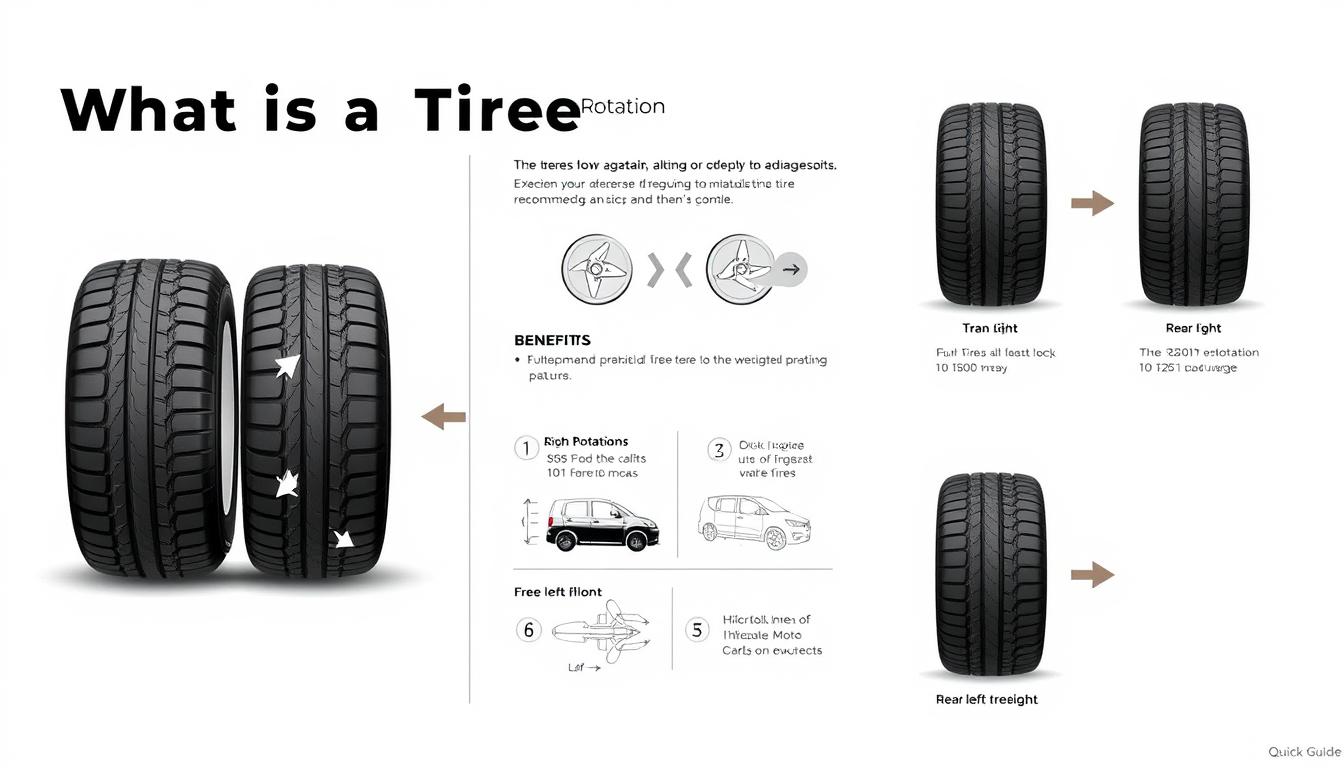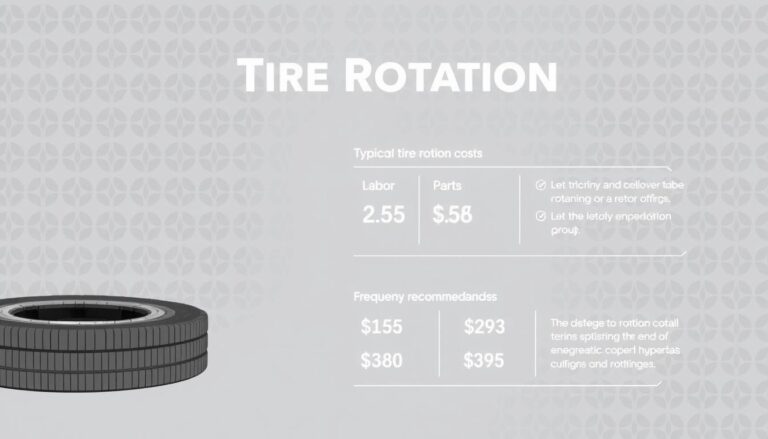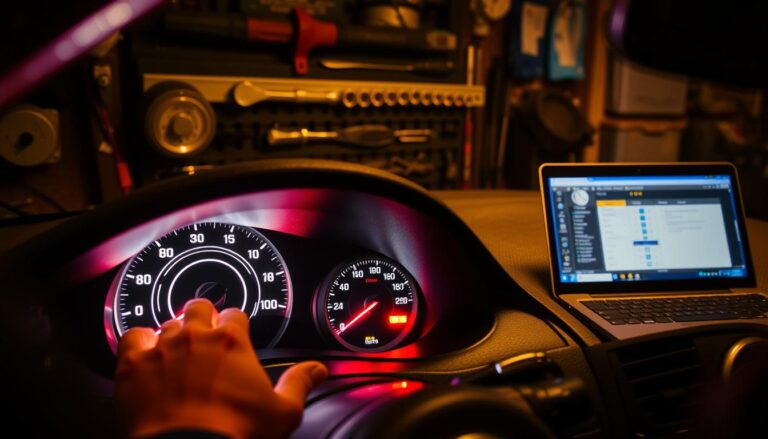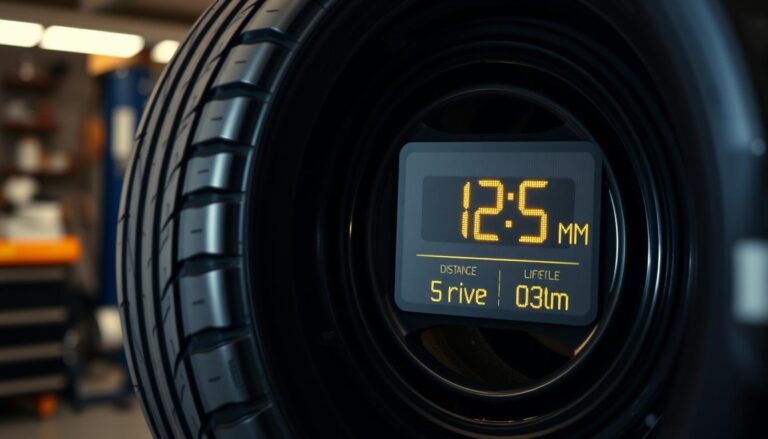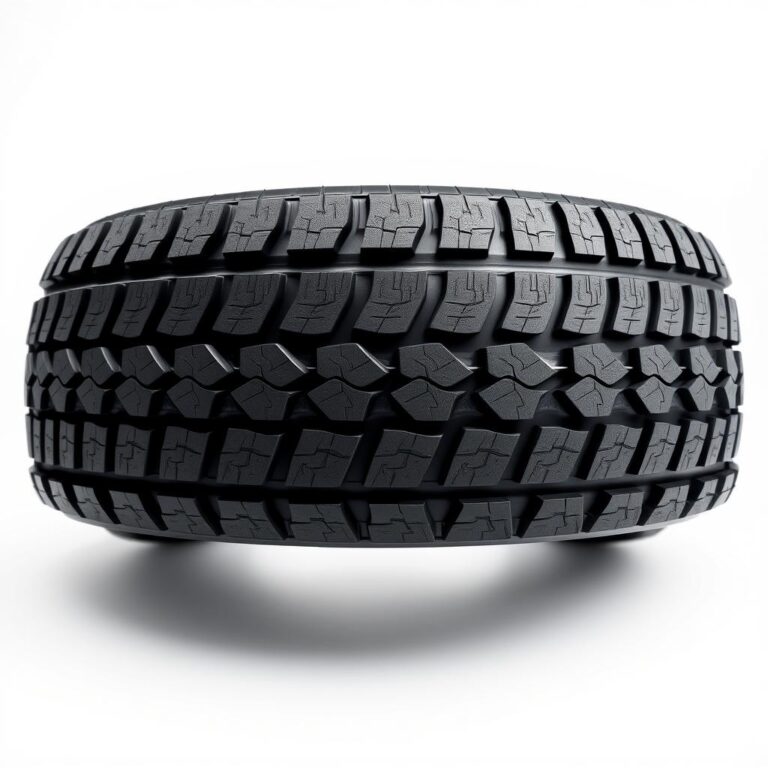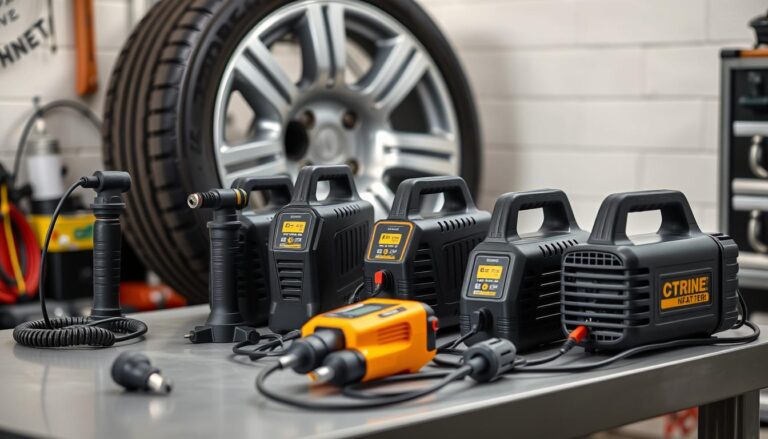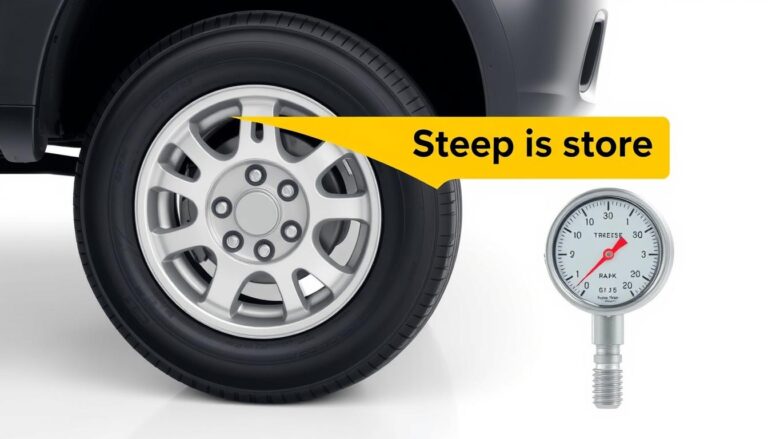What Is a Tire Rotation – Quick Guide
Tire rotation is key for every car owner. It spreads out wear evenly across all tires. This makes your tires last longer and your car run better.
Knowing about tire rotation shows how vital it is for your car. It’s not just about swapping tires. It’s a careful move based on your car’s needs and how you drive.
Driving styles and road conditions cause uneven wear. Front tires get worn down more from steering and braking. Rear tires handle different loads. A good tire rotation balances these, saving you money and keeping your car stable.
Experts say tire rotations are essential for car care. They save you money, improve fuel efficiency, and make driving safer. Without them, your tires wear out unevenly, affecting your car’s stability and safety.
Regular tire rotations are a smart investment. They keep your car running well, safe, and save you money in the long run. It’s more than just maintenance; it’s about making your car perform at its best.
Understanding Tire Rotation Basics
Tire rotation is key to keeping your vehicle running well. It helps your tires last longer and improves your car’s safety and performance.
Good tire care includes several important steps. These steps help your tires work their best:
- Regular pressure checks
- Alignment monitoring
- Consistent tire rotation schedules
- Comprehensive tire wear analysis
Exploring Tire Wear Patterns
Driving in different conditions can wear your tires in different ways. It’s important to know these patterns to understand why tire rotation is so important. Common wear patterns include:
- Center wear: Often caused by overinflation
- Shoulder wear: Usually results from underinflation
- Uneven wear: Indicates possible alignment issues
Vehicle Performance Implications
Regular tire rotations improve your car’s performance. They help your tires wear evenly, leading to better handling and fuel efficiency. They also lower the chance of sudden tire failures.
The benefits of tire rotation are far-reaching. It’s a vital practice for keeping your vehicle safe and running smoothly.
What Is a Tire Rotation
A tire rotation is a key maintenance step. It involves moving your car’s tires to different spots. This helps wear them out evenly and makes them last longer.
When you rotate your tires, you move each one to a new position on your car. This is based on your car’s type. Here’s what a tire rotation includes:
- Changing tire positions across the vehicle’s axles
- Examining tire condition during repositioning
- Checking tire pressure and tread depth
- Identifying possible alignment or suspension issues
Each car needs its own tire rotation pattern. Front-wheel drive cars are different from rear-wheel or all-wheel drive ones. Professional mechanics know these differences and do the rotation right.
Technicians take out each tire and put it in the right spot, as the maker says. This way, wear is spread out. It helps your car handle better, stay safe, and perform well. Plus, it saves money in the long run.
Knowing about tire rotations helps car owners take better care of their tires. Regular rotations are key to keeping your car in good shape. They save money and make driving better.
The Importance of Regular Tire Rotations
Tire rotation is key for keeping your vehicle in top shape. It helps protect your investment and keeps your car running smoothly.
Regular tire rotations are vital for your car’s health and safety. They ensure your tires wear evenly and last longer.
Extended Tire Lifespan Benefits
Regular tire rotations do more than just maintain your car. They:
- Help tires wear evenly
- Lower the chance of needing new tires too soon
- Boost your tires’ performance
Safety Considerations
Uneven tire wear can affect your car’s handling and grip. Proper tire rotation ensures consistent contact with the road. This is key in wet or slippery conditions.
| Rotation Frequency | Potential Benefits |
|---|---|
| Every 5,000-7,500 miles | Maximized tire lifespan |
| Regular maintenance | Improved vehicle safety |
| Consistent rotation | Reduced long-term repair costs |
Cost Savings Over Time
Regular tire rotations save you money in the long run. They prevent uneven wear and help your car use less fuel.
- Potential savings of $100-$300 per year
- Less chance of sudden tire failures
- Better car performance
Sticking to a regular tire rotation schedule is wise. It keeps your tires in great shape and saves you money on repairs.
Signs Your Vehicle Needs Tire Rotation
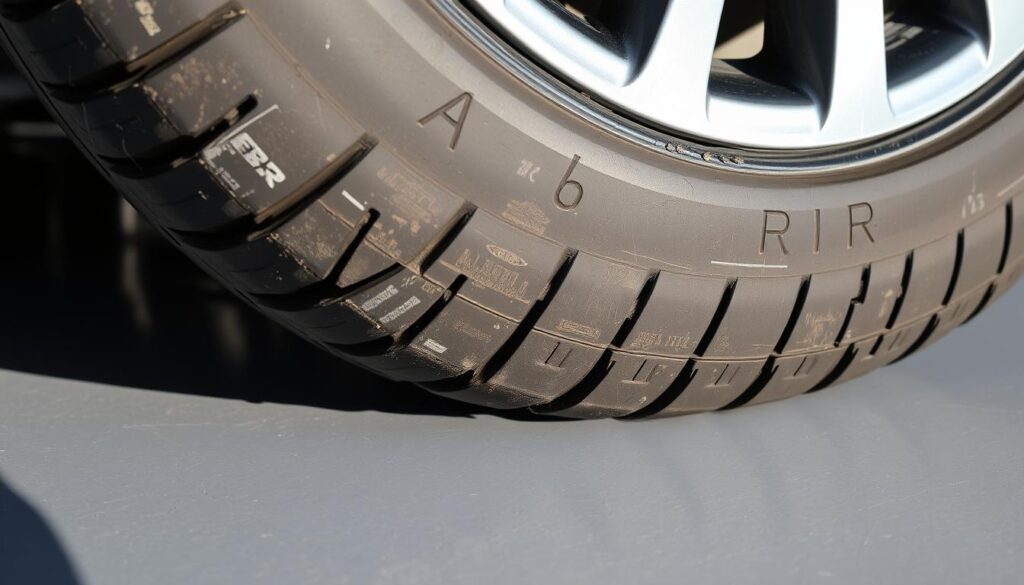
Knowing when to rotate your tires is key for your car’s performance and safety. The frequency of tire rotation depends on several important signs. Drivers should keep an eye out for these.
Uneven tire wear is a big warning sign that your car needs a tire rotation. Look for these specific signs:
- Visible differences in tread depth between front and rear tires
- Unusual vibrations while driving
- Vehicle pulling to one side during normal driving
- Increased road noise or handling inconsistencies
The best time for tire rotation is usually between 5,000 to 8,000 miles. Car makers suggest checking tire wear during regular maintenance. A professional mechanic can quickly tell if your tires need rotation.
Some advanced warning signs include:
- Noticeable bald spots on specific tires
- Uneven tire pressure across different wheels
- Reduced fuel efficiency
Regular visual checks can help you find the best time for tire rotation. Watch your car’s performance and follow expert advice for safe driving.
Common Tire Rotation Patterns Explained
Knowing how to rotate your tires is key to keeping your car running well and your tires lasting longer. Different cars need different patterns to wear evenly and grip the road better.
The way you rotate your tires depends on your car’s drivetrain. Each pattern is made for the unique wear of front-wheel, rear-wheel, and all-wheel drive cars.
Front-Wheel Drive Rotation Patterns
Front-wheel drive cars follow a standard rotation:
- Front tires move straight back to the rear axle
- Rear tires switch sides when moving forward
Rear-Wheel Drive Rotation Considerations
Rear-wheel drive cars need a different rotation:
- Rear tires move straight forward to the front axle
- Front tires switch sides when moving back
All-Wheel Drive Rotation Strategies
All-wheel drive cars have the most complex rotation:
| Tire Position | Rotation Direction |
|---|---|
| Front Left | Rear Right |
| Front Right | Rear Left |
| Rear Left | Front Right |
| Rear Right | Front Left |
Pro tip: Always check your car’s manual for the right tire rotation. Some cars, like performance or luxury ones, might need special care.
Professional Tire Rotation Services vs DIY
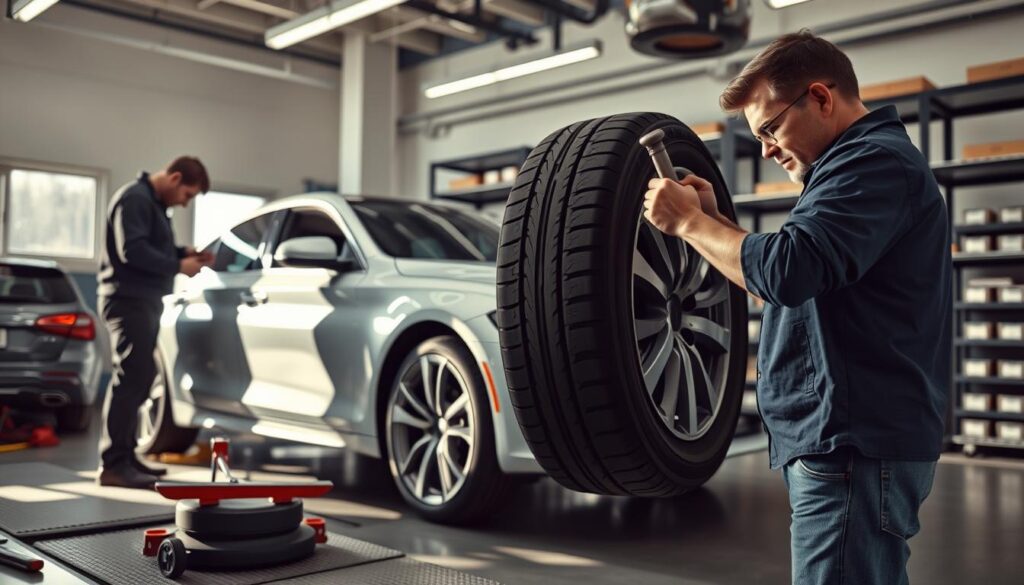
Deciding between a professional tire rotation service and doing it yourself has its pros and cons. Car owners often look for the best way to keep their tires in good shape. They want to find a balance between cost and expertise.
Professional tire rotation services have many benefits. Skilled technicians use their knowledge and special tools to take care of your car. When you search for “tire rotation near me,” you’ll find shops that offer:
- Comprehensive tire inspection
- Specialized alignment checking
- Advanced diagnostic tools
- Warranty-protected service
Doing your own tire rotation can be tough if you’re not mechanically inclined. It might seem cheaper, but you need the right tools and know-how. Potential risks include improper rotation patterns and uneven tire wear.
Here are some times when you should get a professional tire rotation:
- Luxury or high-performance vehicles
- Cars with complex drivetrain systems
- Vehicles under manufacturer warranty
- Limited personal mechanical knowledge
If you’re watching your budget, think about the long-term savings of professional tire rotation. Experts can spot problems early, saving you money and making your tires last longer.
If you’re sure you can handle it, you can try DIY tire rotation. But, most car makers and tire experts say professional services are safer and better for your car’s performance.
How Often Should You Rotate Your Tires
Keeping up with the right tire rotation schedule is key for your car’s performance and tire life. Many drivers ask when the best time is for tire rotation. This question helps them extend their tires’ life and stay safe on the road.
Figuring out the right time for tire rotation depends on a few important things. Most car experts suggest a standard rotation interval. This interval helps balance wear and keeps your car running well.
Mileage Guidelines for Tire Rotation
The usual tire rotation frequency is based on mileage:
- Every 5,000 to 8,000 miles for most cars
- About 6,000 miles for regular driving
- More often for cars that drive a lot or are high-performance
Seasonal Recommendations
Seasonal driving changes can affect when you should rotate your tires. Climate and how you drive are big factors in picking the best time for tire rotation.
Here are some seasonal tips for tire rotation:
- Spring: It’s a good time for a full tire check after winter
- Summer: Check tire wear on long trips
- Fall: Get your tires ready for winter
- Winter: Watch your tire tread and rotation closely
Things that can change how often you need to rotate your tires include:
- What kind of car you have and how it’s driven
- How you drive
- The roads you drive on
- The type of tire and what the maker says
Always check your car’s manual for advice on tire rotation. Mechanics can also give you tips based on your car and how you drive.
The Complete Tire Rotation Process
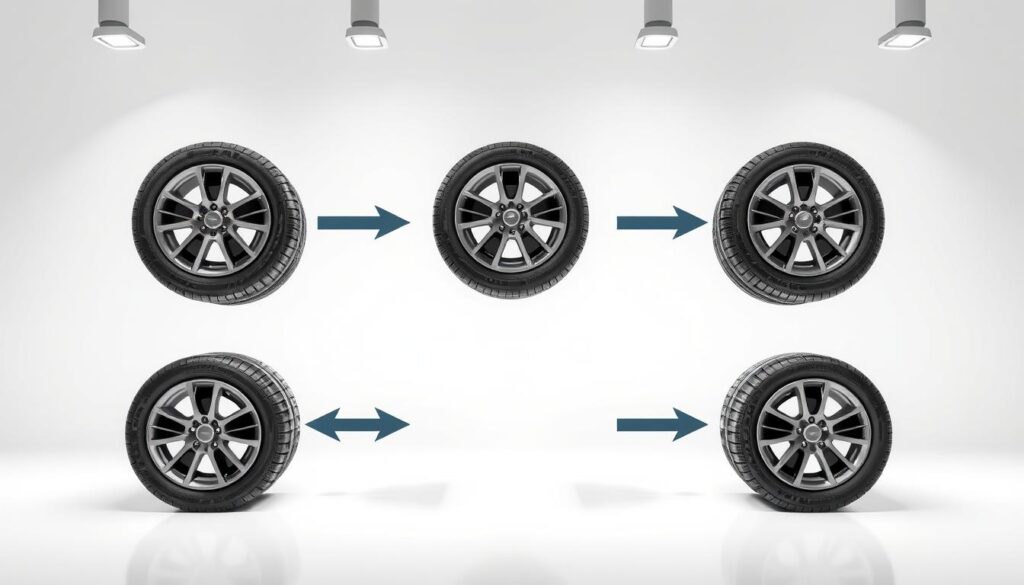
Knowing how to rotate your tires is key for your car’s performance and safety. This guide will show you the steps experts take to make sure your tires last long and your car handles well.
The first step in tire rotation is getting your car ready. Technicians check the tires for wear, damage, and how much tread is left. This helps them decide the best way to rotate your tires.
- Lift the vehicle safely using professional-grade hydraulic lifts
- Remove all four tires carefully
- Inspect tire pressure and tread depth
- Check for any signs of unusual wear or damage
Each car needs a special way to rotate its tires. Cars with front-wheel drive are different from those with rear-wheel or all-wheel drive. Experts choose the best pattern to keep your tires in top shape.
While rotating tires, technicians focus on important details:
- Properly torque lug nuts to manufacturer specifications
- Balance each tire to ensure smooth driving
- Perform a thorough check after rotation
Rotating your tires evenly helps them last longer and keeps your car running well. Knowing about tire rotation helps car owners take better care of their vehicles.
Cost Analysis of Tire Rotation Services
Knowing the cost of tire rotation is key for car owners. It helps keep your car running well and lasting longer. A professional tire rotation service is worth more than its price.
Tire rotation is a cheap way to prevent big expenses later. It usually costs between $20 and $50. This price depends on where you live and what kind of car you have.
Average Service Prices
- Standard passenger vehicle: $20-$30
- SUVs and trucks: $30-$50
- Luxury vehicles: $50-$75
Many auto service centers include tire rotation in their maintenance packages. Some tire shops give complimentary rotations if you buy tires from them.
Long-term Financial Benefits
Regular tire rotation saves you money over time. It makes your tires last up to 25% longer. This can save you hundreds of dollars on new tires.
- Improved fuel efficiency
- Reduced risk of unexpected tire failures
- Enhanced vehicle handling and safety
By focusing on tire rotation, car owners can cut down on maintenance costs. They also keep their cars running at their best.
Finding Reliable Tire Rotation Services Near You

Finding a good tire rotation service can be tough. When you search for tire rotation near me, look for certain things. This ensures your car gets the best care.
Begin by checking out local tire rotation services in different ways:
- Online search directories
- Local automotive repair shops
- Dealership service centers
- Specialized tire shops
When picking a service, do your homework. Look for places with:
- Certified automotive technicians
- Good customer reviews
- Clear prices
- Good warranty options
Good tire rotation services do more than just rotate your tires. They check for wear and can spot problems early. This can save you from bigger issues later.
When choosing a service, ask them questions:
- What rotation pattern do they suggest?
- Do they check tire pressure and balance?
- How long will it take?
- What’s the cost?
Tire rotation prices vary from $20 to $50. This depends on your car and where you live. Many places offer deals that include other car services.
Choosing a trusted local service can help your car in the long run. It’s good for maintenance and performance.
Combining Tire Rotation with Other Maintenance
Good car care is more than just one thing. Mixing tire rotation with other important checks can make your car run better and last longer. Planning ahead saves time and money, and keeps your car in top shape.
Tire rotation does more than just move the wheels. It’s part of a bigger plan to keep your car in great condition. This way, you protect your investment.
Alignment Services: A Perfect Complement
Wheel alignment and tire rotation go hand in hand. During a tire rotation, techs can check your wheel alignment. This helps:
- Stop uneven tire wear
- Make your car handle better
- Save on gas
- Less stress on your suspension
Brake Inspections: Synchronized Maintenance
Putting tire rotation and brake checks together is smart. Both need the wheels off, so you:
- Save time at the mechanic
- Lower your maintenance costs
- Get a thorough safety check
- Catch problems early
Car experts say it’s best to book these services together. It boosts your car’s performance and efficiency.
Special Considerations for Different Vehicle Types
Tire rotation needs change a lot for different cars. Knowing these changes helps keep tires in top shape and makes them last longer.
Sports cars need special care when rotating their tires. They often have:
- Staggered wheel sizes
- High-performance summer tires
- Specific rotation patterns based on drivetrain configuration
SUVs and trucks face unique challenges with tire rotation. Their heavy weight and big tires need careful planning. Things like four-wheel drive and off-roading affect how often and how they should be rotated.
Electric vehicles (EVs) have their own set of rules for tire rotation. Their heavy batteries cause uneven wear, so they need:
- More frequent rotations
- Specialized alignment checks
- Careful monitoring of tire pressure
Run-flat tires and advanced tire pressure monitoring systems make things more complicated. Always check your car’s manual and talk to a pro for the right care.
Pro tip: Always refer to your vehicle’s owner manual for precise tire rotation guidelines tailored to your specific make and model.
Common Myths About Tire Rotation
Tire rotation is key to keeping your car safe and running well. Yet, many people don’t understand it right. This can put their car and themselves at risk.
Many car owners believe wrong things about tire rotation. Knowing why it’s important helps them take better care of their car.
Debunking Popular Misconceptions
- Myth: New tires don’t need rotation
New tires need rotation too. It helps them wear evenly and last longer, no matter how new they are.
- Myth: All tires wear at the same rate
Tires wear differently because of how you drive and the car you have. The front, rear, and drive wheels get worn in different ways. That’s why rotation is key.
- Myth: Tire rotation is unnecessary for all-wheel-drive vehicles
All-wheel-drive cars actually need tire rotation more. Their complex systems benefit from it.
Expert Insights
Car experts say tire rotation is not just a good idea. It’s a must. Skipping it can mean your tires wear out too soon and could be dangerous.
Sticking to a tire rotation schedule keeps your car running smoothly. It also saves fuel and makes driving safer.
Impact of Tire Rotation on Vehicle Performance
Tire rotation does more than just keep your tires looking good. It’s key to your car’s performance and how it feels to drive. By switching tire positions, you get better handling, grip, and gas mileage.
Knowing why tire rotation matters helps you see how uneven wear hurts your car. Even wear gives you:
- Improved road grip in various weather conditions
- Enhanced vehicle stability
- More balanced driving dynamics
- Reduced risk of unexpected tire failures
Proper tire rotation keeps your wheels aligned and balanced. This means less shaking and smoother rides. You’ll handle tough roads better, like when it’s wet or slippery.
| Performance Aspect | Impact of Regular Tire Rotation |
|---|---|
| Traction | Increased road contact and grip |
| Fuel Efficiency | Reduced rolling resistance |
| Vehicle Handling | More predictable and stable steering |
| Tire Lifespan | Extended tire durability |
Regular tire rotations make your car better and safer. It’s a small step that pays off big in the long run. Your car will perform better, and you’ll feel more confident behind the wheel.
Conclusion
Knowing about tire rotation is key to keeping your car in top shape. It’s more than just a simple car service. Regular rotations help your car run better, stay safe, and keep its value high. By rotating tires often, you can avoid uneven wear and make driving more enjoyable.
The role of tire rotation in keeping your car running well is huge. Mechanics say following the car maker’s advice and getting regular rotations is a must. This even wear helps your tires last longer and keeps you safe from the dangers of uneven tires.
Seeing tire rotation as a way to care for your car is smart. The right rotation plan for your car and how you drive it keeps your tires working their best. Taking care of your tires means better handling, saving money, and staying safe on the road.
Make sure tire rotation is a regular part of your car care. Get advice from experts who know your car and how you drive. Taking good care of your tires means smoother rides, better safety, and saving money in the long run.
